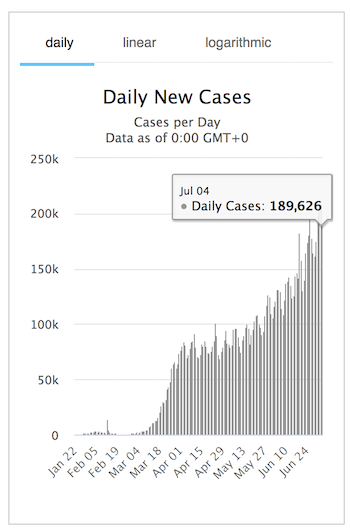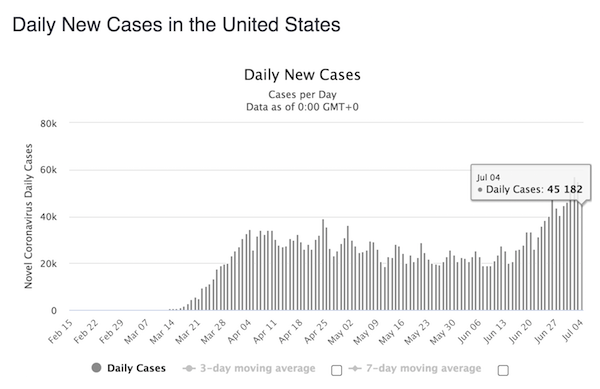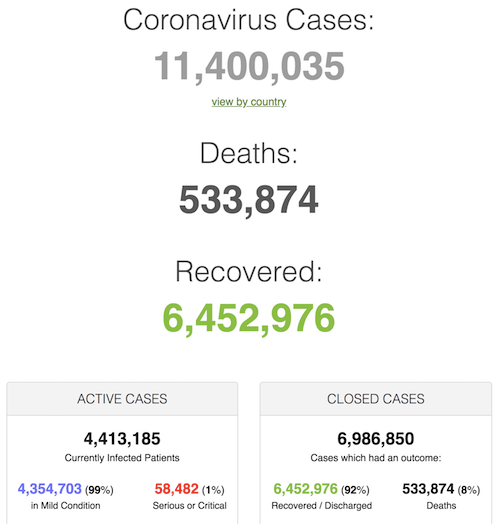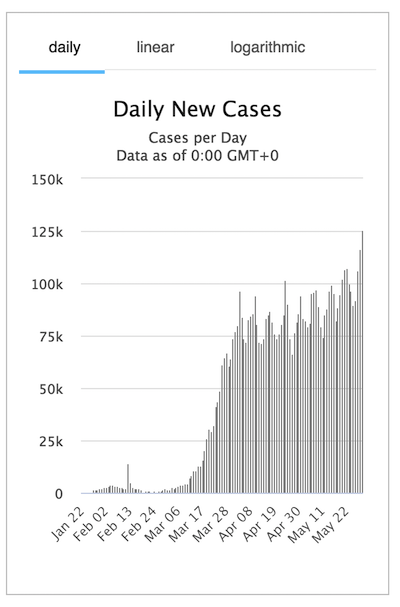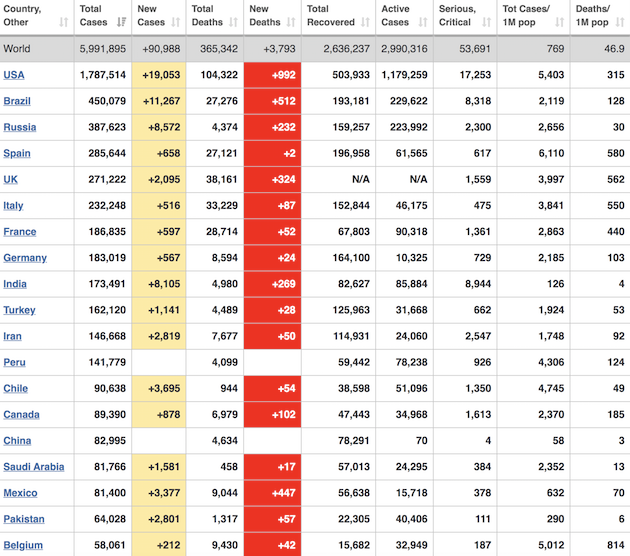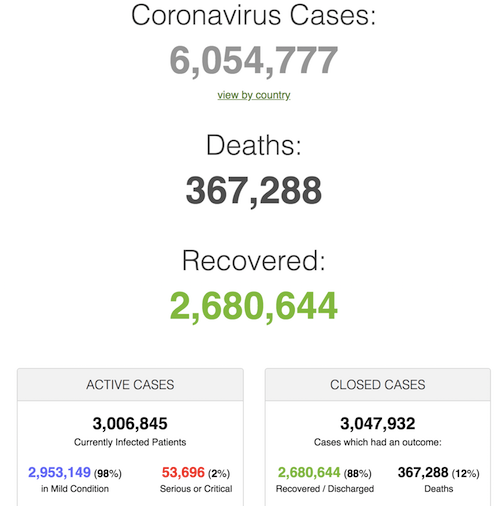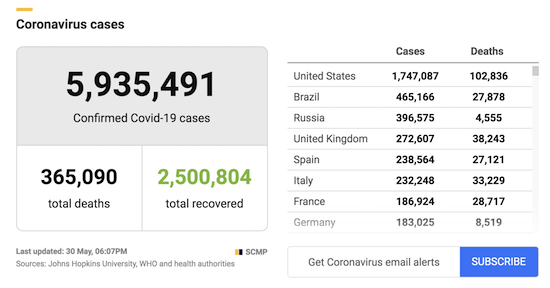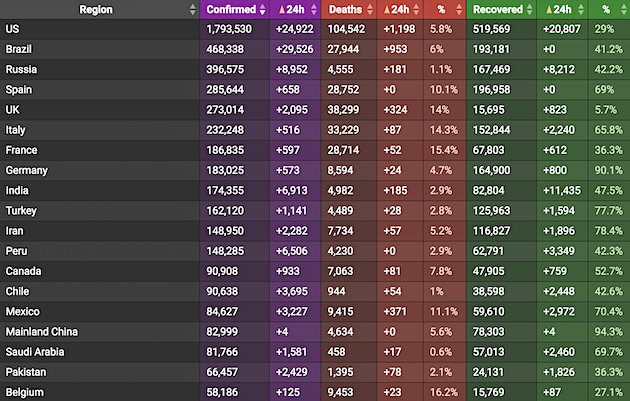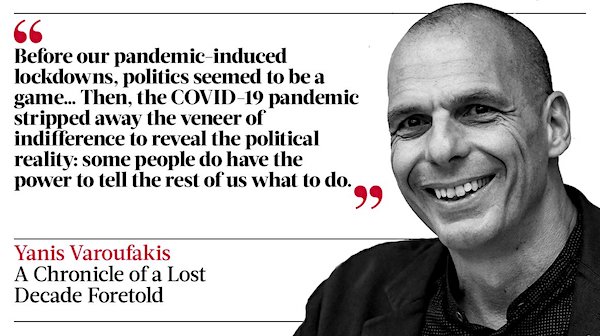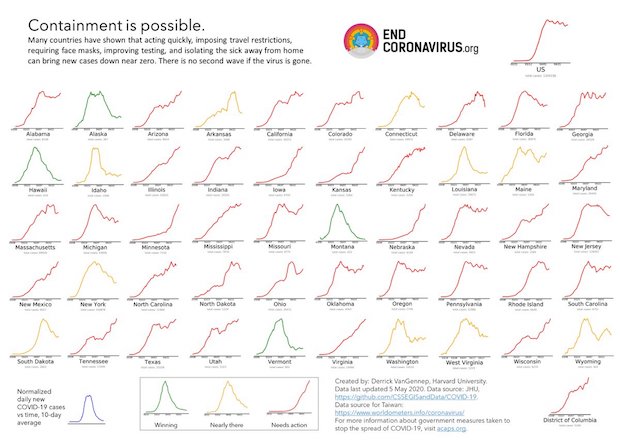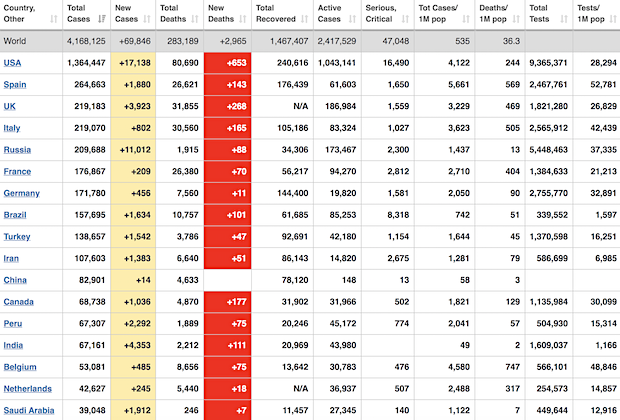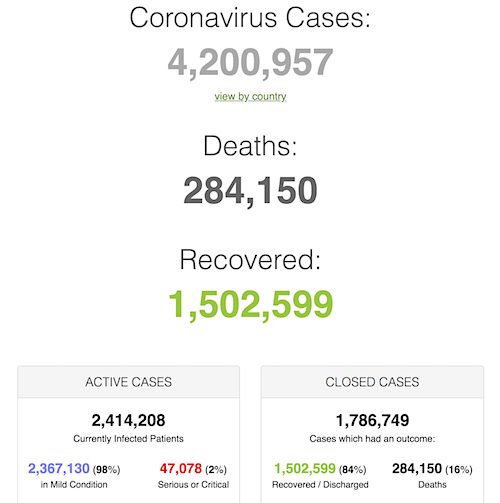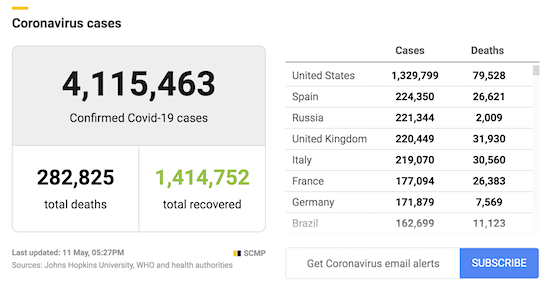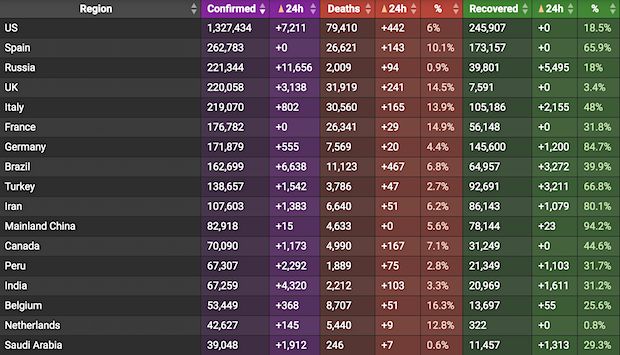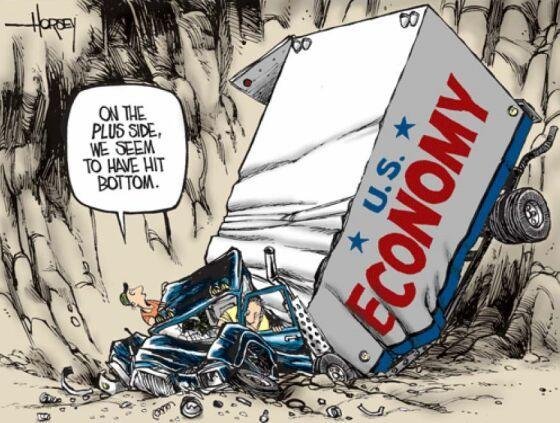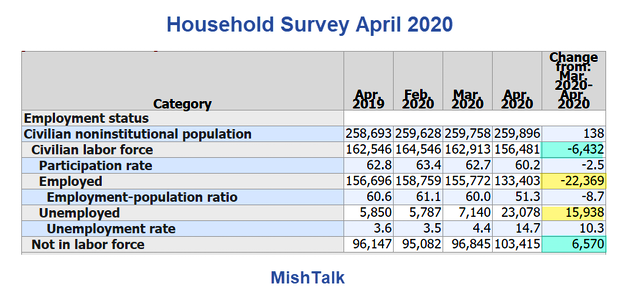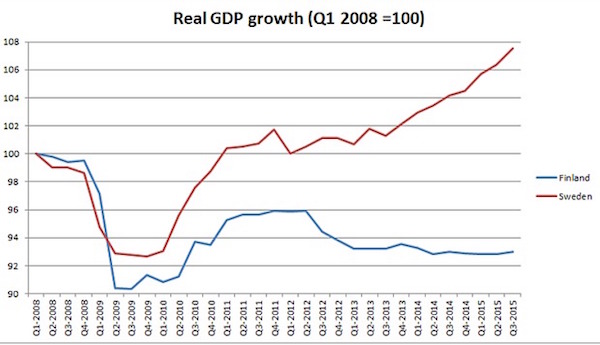
John Vachon Paramount Theater and dairy truck, 44th Street, NYC 1943

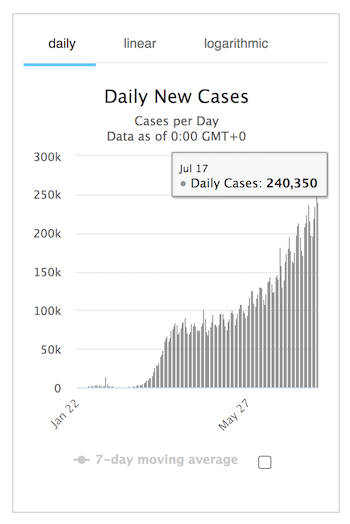
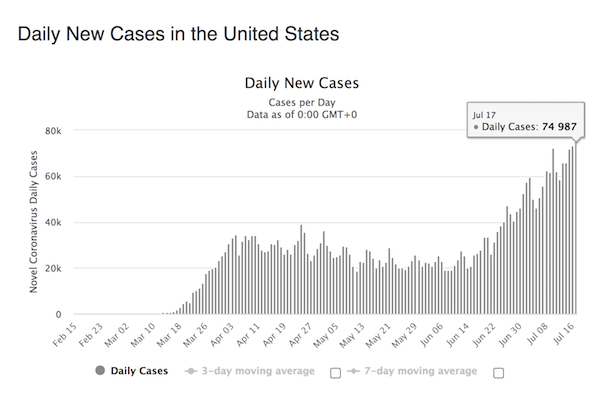

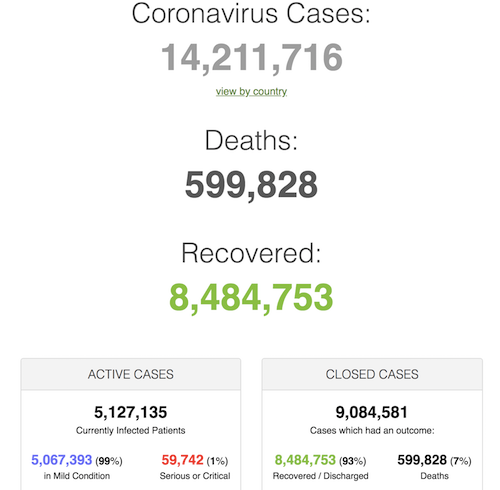

Maté NYT
Do they stand by this story that Strzok refuted privately, Comey refuted publicly, & Mueller found no evidence of like they stand by their Russia bounty story, which their own reporting contradicted? https://t.co/lqcE3bPQ5B
That’s not standing by reporting, it’s denying reality.
— Aaron Maté (@aaronjmate) July 18, 2020

“Hydroxychloroquine’s main function within this treatment approach is to allow zinc to enter the cell. Zinc is the virus killer..”
• Zelenko Study Suggests HCQ, Zinc Effective as Early Corona Treament (PRN)
Dr. Vladimir Zelenko, a New York based primary care physician, announced that a retrospective analysis based on his patient data is available to read online at www.thezelenkoprotocol.com. The study, which has been submitted for peer review, found that early intervention and treatment of risk stratified COVID-19 patients in the outpatient setting resulted in five times less hospitalizations and deaths. The medications used in the treatment approach were zinc, low dose hydroxychloroquine, and azithromycin. Prior studies of COVID-19 treatments have been largely based on severely ill patients in the hospital. This study examines outcomes of patients treated after their first visit to the doctor’s office.
Using simple risk stratification criteria, Dr. Zelenko identified which patients required prescriptions for the triple drug therapy, and prescribed these medications for five days. To produce the study, Zelenko collaborated with Dr. Roland Derwand, a German medical doctor and life science industry expert, and Professor Martin Scholz, an independent consultant and adjunct professor for experimental medicine at Heinrich Heine University, Düsseldorf, Germany. Derwand and Scholz performed the data analysis while Zelenko handled all in-person treatments. The main results show that of 141 patients who were treated with the triple therapy, only 2.8% (4/141) were hospitalized compared to 15.4% of an untreated control group (58/377) (odds ratio 0.16, 95% CI 0.06-0.5; p<0.001).
Only 0.71% (1/141) patients died in the treatment group, versus 3.5% (13/377) in the untreated group (odds ratio 0.2, 95% CI 0.03-1.5; p=0.16). “These three medications are affordable, available in pill form, and work in synergy against COVID-19,” said Zelenko. “Hydroxychloroquine’s main function within this treatment approach is to allow zinc to enter the cell. Zinc is the virus killer, and azithromycin prevents secondary bacterial infection in the lungs and reduces the risk of pulmonary complications.” “The world seems to have forgotten common medical knowledge: that we want to treat any patient with an infectious disease as soon as possible,” said Derwand. “What differentiates this study is that patients were prescribed these medications early, in the outpatient setting. Dr. Zelenko treated his risk stratified patients immediately and didn’t wait for the disease to intensify.”
“The well-tolerated 5-day triple therapy resulted in a significantly lower hospitalization rate and less fatalities with no reported cardiac side effects compared with relevant public reference data of untreated patients,” said Sholz. “The magnitude of the results can substantially elevate the relevance of early use, low dose hydroxychloroquine, especially in combination with zinc. This data can be used to inform ongoing pandemic response policies as well as future clinical trials.” “It’s unfortunate much of the news coverage surrounding hydroxychloroquine has been negative,” Zelenko added. “This study suggests that when taken early and together with zinc and azithromycin, this cost-effective drug can be part of the solution to the pandemic.”

Shame they don’t explain what that double thing might be. Reads like an ad.
• Oxford Vaccine Could Provide ‘Double Protection’ (Sky)
Researchers at the University of Oxford believe they have made a breakthrough in the development of a coronavirus vaccine. Human trials are reported to have shown promising results after the team discovered the jab could provide “double protection” against the virus. Blood samples taken from volunteers in phase one trials have shown the vaccine stimulated the body to produce antibodies and T-cells, according to a report in The Daily Telegraph. T-cells play a central part in the body’s immune response. A source told the newspaper that the combination “will hopefully keep people safe”. The vaccine is one of more than 100 in development as the coronavirus continues to spread – infecting more than 13 million people and killing at least 582,000.
David Carpenter, chairman of the Berkshire Research Ethics Committee, which approved the Oxford trial, said the vaccine team was “absolutely on track”. He added: “Nobody can put final dates… things might go wrong but the reality is that by working with a big pharma company, that vaccine could be fairly widely available around September and that is the sort of target they are working on.” The vaccine development is being supported by the UK government and AstraZeneca. The pharmaceutical company’s chief executive said last month that phase one trials were due to finish and a phase three trial had begun which will see the vaccine given to thousands of people so it can be tested for efficacy and safety.
The firm has reached agreements to supply around two billion doses worldwide, despite acknowledging that it is not yet certain the vaccine will work. The vaccine is based on a weakened version of the common cold that causes infections in chimpanzees. It also contains the genetic material of the spike protein of SARS-CoV-2 – the strain of coronavirus that causes the COVID-19 illness. The UK government has also given £41m to the development of another coronavirus vaccine being developed by London’s Imperial College.

If you let an algoritm do your work for you, it had better be a very good one. This feels shaky.
• Coronavirus Symptoms Fall Into Six Different Groupings (G.)
Symptoms of Covid-19 appear to fall into six different groupings, researchers have revealed, in work they say could help to predict whether a patient will end up needing a ventilator or other breathing support. The team say the findings could give healthcare providers several days advanced warning of demand for hospital care and respiratory support. But it could also help flag patients at risk of becoming seriously ill, meaning home support, such as an oxygen meter or nurse visits, could be provided so that any deterioration is spotted quickly and hospital attendance is prompt. At present, the team added, the average time to get to hospital with Covid-19 is 13 days.
[..] The researchers drew on data from 1,653 users who tested positive for Covid-19, reported persistent symptoms and regularly logged updates on their health and situation. Overall, 383 of these users made at least one trip to hospital, and 107 required either extra oxygen or ventilation. [..] The team then used machine learning algorithms – a type of artificial intelligence – to explore whether some symptoms, among the 14 monitored, cluster together. The results suggest six different groupings based on the type of symptoms, when they occurred, and their duration within the first 14 days of participants’ sickness.
And there was more. “We saw that there was a very clear gradient between these clusters and outcomes in terms of [participants’ need for] respiratory support,” said Dr Claire Steves, clinical senior author on the paper from King’s College London, adding other factors such as older age or certain pre-existing medical conditions were more common in some groups.
The six groupings, or “clusters”, are:
Cluster 1: Mainly upper respiratory tract symptoms, such as a persistent cough, with muscle pain also present. About 1.5% of patients in this group required respiratory support, with 16% making one or more trips to hospital. This was the most common cluster of symptoms, affecting 462 participants.
Cluster 2: Mainly upper respiratory tract symptoms, but also a greater frequency of skipped meals and fever. Of patients in this group 4.4% required respiratory support, with 17.5% making one or more trips to hospital.
Cluster 3: Gastrointestinal symptoms such as diarrhoea, but few other symptoms. While only 3.7% of patients in this group later needed respiratory support, almost 24% made at least one visit to hospital.
Cluster 4: Early signs of severe fatigue, continuous chest pain and cough. Of patients in this group 8.6% required respiratory support, with 23.6% making one or more trips to hospital.
Cluster 5: Confusion, skipped meals and severe fatigue. Of patients in this group 9.9% required respiratory support, with 24.6% making one or more trips to hospital.
Cluster 6: Marked respiratory distress including early onset of breathlessness and chest pain, as well as confusion, fatigue and gastrointestinal symptoms. Almost 20% of this group needed respiratory support and 45.5% made one or more visits to hospital. But this was the least common symptom cluster, affecting 167 participants.

The theories they base their decisions on are either outdated, plain wrong or made up on the spot. They have one thing in common: they benefit banks, not people. As long as the Fed remains in place, the US will never have a healthy economy.
• The Fed Is Setting The Stage For A Major Policy Change (BBG)
For the Federal Reserve, this time really is different. Having learned a hard lesson in the last recovery – don’t tighten monetary policy too early – the central bank is leaning in the opposite direction. In practice, that means the Fed will not just emphasize actual inflation over forecasted inflation, but will also attempt to push the inflate rate above its 2 per cent target. It’s a whole new ballgame. The Fed’s traditional Phillips curve approach to forecasting inflation, which relies on the theory that inflation accelerates as unemployment falls, was widely criticized during the most recent economic recovery. Inflation remained quiescent in the wake of the Great Financial Crisis even as the unemployment rate fell to 3.5 per cent, well below the 2012 high estimate of the natural rate, or 5.6 per cent.
The Fed’s commitment to Phillips curve-based inflation forecasts induced it to raise interest rates too early in the cycle and continue to boost rates into late 2018 even as faltering markets signaled the hikes had gone too far. The Fed was eventually forced to lower rates 75 basis points in 2019 to put a floor under the economy. Inflation remained stubbornly below the Fed’s 2 per cent target throughout that period. Faced now with the prospect of another prolonged period of low inflation, Fed officials are signaling they will place less emphasis on Phillips curve estimates when setting policy. Fed Governor Lael Brainard said this week that “with inflation exhibiting low sensitivity to labor market tightness, policy should not preemptively withdraw support based on a historically steeper Phillips curve that is not currently in evidence.”
No longer are estimates of longer-run unemployment taken as almost certainly indicating the economy is at full employment. Instead, Brainard said the Fed should focus on achieving “employment outcomes with the kind of breadth and depth that were only achieved late in the previous recovery.” The Fed is going to try to run the economy hot to push down unemployment. By de-emphasizing the Philips curve, the Fed loses its primary inflation forecasting tool. Instead of an inflation forecast, the Fed will rely on actual inflation outcomes to determine the appropriate time to change policy. Brainard pointed out that “research suggests that refraining from liftoff until inflation reaches 2 per cent could lead to some modest temporary overshooting, which would help offset the previous underperformance.”

The sheer quantity of the economic losses may well tear the EU apart. The rich countries have rich citizens to answer to, the poor have different problems.
• EU Leaders Deadlocked Over COVID Recovery Plan (R.)
EU leaders failed on Friday to make headway in negotiations over a massive stimulus plan to breathe life into economies ravaged by the coronavirus pandemic, returning to their Brussels hotels shortly before midnight to rest and try again in the morning. Many of the 27 heads declared on arrival for their first face-to-face summit for five months that a deal was crucial to rescue economies in free fall and shore up faith in the European Union, which has lurched for years from crisis to crisis. But officials said a thrifty camp of wealthy northern states led by the Netherlands stood its ground on access to the recovery fund, in the face of opposition from Germany, France, southern nations Italy and Spain, and eastern European states.
The proposed sums under discussion include the EU’s 2021-27 budget of more than 1 trillion euros and the recovery fund worth 750 billion euros that will be funneled mostly to Mediterranean coast countries worst affected by the pandemic. Diplomats said the 27 remained at odds over the overall size of the package, the split between grants and repayable loans in the recovery fund and rule-of-law strings attached to it. But the main stumbling block was over vetting procedures to access aid, an EU official said, with Dutch Prime Minister Mark Rutte demanding that one country could block payouts from the fund if member states backslide on economic reform. “If they want loans and even grants then I think it’s only logical that I can explain to people in the Netherlands … that in return those reforms have taken place,” Rutte said, estimating the chances for a deal at fifty-fifty.
Polish premier Mateusz Morawiecki was even more gloomy. As the leaders broke up for the day, he tweeted that they were divided by a bundle of issues and said it was “highly probable” that they would fail to reach a deal on Saturday or even on Sunday if the summit drags past its scheduled two days. German Chancellor Angela Merkel, who celebrated her 66th birthday around the negotiating table in Brussels, was also cautious on chances for an agreement, envisaging “very, very difficult negotiations”.

Recovery plan: 1%. Austerity: 4%.
• As EU Leaders Squabble, The Elephant In The Room Goes Unnoticed (Varoufakis)
While the media are reporting the news of the deadlocked EU Summit negotiations over the so-called ‘Recovery Fund’, an eerie silence prevails regarding the Elephant in the Room: The huge wave of austerity the Eurozone is sleepwalking towards. Let’s look at the facts. Even if the Dutch Prime Minister, Mr Rutte, and the rest of the ‘frugal four’, were to remove their objections to the Recovery Fund’s terms and conditions, the net fiscal effect across the Eurozone will be no more than 1% annually for three years. Now, let us turn to the Elephant in the Room: the dreaded return of the obligation to balance government budgets, the infamous Fiscal Compact.
According to the optimistic scenario of the European Commission, the Eurozone’s mean government budget in 2020 will be -8% of total Eurozone GDP . Of this, next year, the nascent steady-state recovery will remove, at best 4%, leaving the Eurozone, on average, with a -4% 2021 budget deficit. Moreover, as this is a mean, some countries (e.g. Italy and Greece) are facing, in 2021, a steady state budget deficit in excess of -8% (down from -15% in 2020). Which means that, to get back to balanced budgets, on average, the Eurozone will impose upon itself fiscal austerity of approximately 4% of its aggregate GDP, with countries like Italy and Greece facing an austerity nightmare in excess of 8% of their crushed GDP.
If this were to be allowed to happen, the Recover Fund’s 1% annual fiscal boost will be countered by a 4% fiscal austerity wave. As Europe begins to recover from the pandemic’s disastrous effects, Brussels will be hitting our economies over the head with a sledgehammer. And yet, ultimate proof that the EU’s establishment resembles the Bourbons (in that they forget nothing and learn nothing!), our great and good leaders refuse to discuss this ominous Elephant in the Room, choosing instead to invest hours in endless negotiations over the 1% fiscal boost and whether it should be reduced or how it will be managed.

This is America.
• On Eve Of Bankruptcy, US Firms Shower Execs With Bonuses (R.)
Nearly a third of more than 40 large companies seeking U.S. bankruptcy protection during the coronavirus pandemic awarded bonuses to executives within a month of filing their cases, according to a Reuters analysis of securities filings and court records. Under a 2005 bankruptcy law, companies are banned, with few exceptions, from paying executives retention bonuses while in bankruptcy. But the firms seized on a loophole by granting payouts before filing. Six of the 14 companies that approved bonuses within a month of their filings cited business challenges executives faced during the pandemic in justifying the compensation.Even more firms paid bonuses in the half-year period before their bankruptcies.
Thirty-two of the 45 companies Reuters examined approved or paid bonuses within six months of filing. Nearly half authorized payouts within two months. Eight companies, including J.C. Penney and Hertz, approved bonuses as few as five days before seeking bankruptcy protection. Hi-Crush Inc, a supplier of sand for oil-and-gas fracking, paid executive bonuses two days before its July 12 filing. J.C. Penney – forced to temporarily close its 846 department stores and furlough about 78,000 of its 85,000 employees as the pandemic spread – approved nearly $10 million in payouts just before its May 15 filing. On Wednesday, the company said it would permanently close 152 stores and lay off 1,000 employees.
[..] Luxury retailer Neiman Marcus Group in March temporarily closed all of its 67 stores and in April furloughed more than 11,000 employees. The company paid $4 million in bonuses to Chairman and Chief Executive Geoffroy van Raemdonck in February and more than $4 million to other executives in the weeks before its May 7 bankruptcy filing, court records show. Neiman Marcus drew scrutiny this week on a plan it proposed after filing for bankruptcy to pay additional bonuses to executives. Hertz – which recently terminated more than 14,000 workers – paid senior executives bonuses of $1.5 million days before its May 22 bankruptcy, in part to recognize the uncertainty they faced from the pandemic’s impact on travel, the company said in a filing.

Turley is overly diplomatic. CNN left objectivity behind a long time ago. CNN only still exists because Trump exists and they can dump on him 24/7.
• A Tale of Two CNNs: A Network Struggling With Objectivity (Turley)
There was a telling moment of dissonance on CNN this week, a network that is now unrelenting in its negative and highly partisan coverage of the Administration. CNN’s White House reporter Jim Acosta has been repeatedly called out for such bias and sent out a clearly misleading tweet bashing White House press secretary Kayleigh McEnany. Meanwhile, CNN host Jake Tapper set the record straight in fairness to McEnany. While I have occasionally criticized Tapper, I have more often praised him for his professionalism and intellect. This is why. This is what CNN was once and, with the help of figures like Tapper, it could be again: an honest and objective news organization.
In Thursday’s briefing, McEnany repeated President Trump’s call for children to go back to school in the fall. “The science should not stand in the way of this, but as Dr. Scott Atlas said — I thought this was a good quote, ‘Of course, we can do it. Everyone else in the Western world, our peer nations are doing it. We are the outlier here.’ The science is very clear on this. For example, you look at the JAMA pediatric study of 46 pediatric hospitals in North America that said the risk of critical illness from COVID is far less for children than the seasonal flu. The science is on our side here. We encourage localities and states to just simply follow the science. Open our schools.”
She is clearly citing the science as supporting the position of the Administration. However, Acosta clipped the statement to make it sound like McEnany was dismissing the relevance of science: “The White House Press Secretary on Trump’s push to reopen schools: ‘The science should not stand in the way of this.’” That was clearly and absolutely false. However, Acosta knew that it would play well in the eco-journalistic model adopted by CNN. He quickly racked up 30,000 retweets. He then later added that McEnany actually meant the opposite. That received less than 700 retweets. It is the ultimate example of the demand of many viewers to only hear news that supports their own bias and adds to a type of journalistic comfort zone.
That was clearly and absolutely false. However, Acosta knew that it would play well in the eco-journalistic model adopted by CNN. He quickly racked up 30,000 retweets. He then later added that McEnany actually meant the opposite. That received less than 700 retweets. It is the ultimate example of the demand of many viewers to only hear news that supports their own bias and adds to a type of journalistic comfort zone. To Acosta’s credit, he sent out the second tweet, but saying “McEnany went on to say ‘the science is on our side here’” does not quite capture the scene. The quote was McEnany referring to a scientific study and, right after the line quoted, McEnany said “The science is very clear on this.” She then two lines later added “The science is on our side here.” The entire quote was McEnany raising a scientific study that supports their position.
It is akin to a McEnany saying “National security is not relevant because the Defense Department report supports this policy” only to have Acosta tweet “The White House Press Secretary: “National Security is not relevant” in White House policy. Over at CNN headquarters however Tapper stepped out of that comfort zone and corrected CNN’s chief medical correspondent Dr. Sanjay Gupta after he repeated the same false narrative that McEnany was having an “alternative facts kind of moment.” Tapper responded: “If I could just say, Sanjay,. I think she was just trying to say that the science shouldn’t stand in the way because the science is on our side. I don’t know that all of the science is on their side- and certainly, this White House, their respect for science knows bounds, let’s put it that way, but I think that’s what she was getting at.”

Where the real battle is.
• St. Louis Prosecutor Targeting McCloskeys Gets $78,000 From Soros Group (JTN)
The Missouri Justice Public Safety PAC, which is linked to George Soros, has donated nearly $78,000 in contributions to St. Louis Circuit Attorney Kim Gardner’s 2020 campaign, according to her July 15, 2020 financial report, obtained by Just the News. Missouri Justice & Public Safety PAC, which donated the amount through in-kind contributions, was contacted for this story but has yet to respond with comment. The Washington, D.C.-based political action committee is listed at the same street address as one that contributed to Gardner’s 2016 campaign. The Safety and Justice PAC that contributed to the 2016 campaign has the same 13th Street NW address of the Missouri Justice & Public Safety PAC. Both have financial links to Soros.
“Yes, it’s no secret we contribute to Safety and Justice PACs,” Soros spokesman Michael Vachon, told Just the News. “We are for criminal justice reform.” The Gardner campaign filed its financial report on Thursday, the same day Missouri GOP Sen. Josh Hawley sent a letter to Attorney William Barr calling for a federal civil rights investigation into Gardner. Gardner, St. Louis’ top prosecutor, remains under criminal investigation for her handling of the criminal investigation into former Republican Gov. Eric Greitens. More recently, Gardner has targeted Mark and Patricia McCloskey for defending their home June 28 when they brandished their guns as hundreds of Black Lives Matters protestors trespassed onto their property as they headed to the St. Louis mayor’s home.
The protesters barged through the McCloskeys’ privately closed gate and onto their private road. President Trump and Missouri Governor Michael Parson have even weighed in with concern for how Gardner is handling the situation. Hawley, who is the former Missouri attorney general, argues that Gardner has abused her office after seizing McCloskey’s guns while pursuing a possible indictment of the married couple.

I’m so surprised I can’t tell you. These wankers receive over $30 million a year from governments?! To do what? Plants chemical canisters twice a year?
• White Helmets Co-Founder Stole Aid Money Destined For Syria (RT)
As Western governments opened their checkbooks for the White Helmets – a controversial ‘rescue organization’ in Syria – their co-founder used the cash to top up his wage and even finance his wedding, according to a Dutch report. Days before he plunged from a window in Istanbul to his death last year, White Helmets co-founder and British mercenary James Le Mesurier admitted to defrauding Mayday Rescue, an organization that fundraised for the anti-government rescue group in Syria. According to documents seen by Dutch newspaper De Volkskrant, Le Mesurier told an accountant sent to audit the charity’s books that he forged receipts for $50,000, pretending that it was sent to finance an evacuation operation in Syria.
Instead, the money was paid to Le Mesurier himself. In addition to paying himself a salary of €24,000 ($27,414) per month, Le Mesurier dipped into company cash to finance a lavish wedding in Istanbul in 2018, and to issue loans to his new wife, former diplomat Emma Winberg, the report claims. The accountant sent to investigate Mayday found that “tens of thousands of dollars in cash” were withdrawn to pay for the “fairytale wedding.” Meanwhile, governments across the Western world were lining up to support Mayday, and channel money to the White Helmets. According to a 2018 report by the Dutch Ministry of Foreign Affairs, the organization took in $127 million between 2014 and 2018, with only $19 million of this haul coming from non-state donors.
The government of the Netherlands paid out almost $11.5 million in this period, while similar donations flowed in from Germany, Great Britain, Canada, Qatar, and others. Despite being hailed as fearless rescue workers, the White Helmets have been accused of partnering with Al-Qaeda. Operating exclusively in rebel-held territory, the group’s members have been photographed posing with jihadists and have been accused of staging chemical weapons attacks to draw in Western forces against Syrian President Bashar Assad. Le Mesurier’s death was deemed a suicide by Turkish authorities. Shortly afterwards, a number of countries that had donated to Mayday demanded an accountant have another look over the organization’s books. According to De Volkskrant, this probe found that most of Mayday’s financial records are “missing.” Donations were not just handed to the organization in Amsterdam and forwarded to Syria, but distributed through a network of commercial organizations in Turkey and Dubai.

Less than four months until the election.
• Docs Show Peter Strzok Tore Apart NYT Report On Trump-Russia Contacts (DC)
An FBI document released Friday details at least 14 inaccuracies in a New York Times report from early 2017 that leveled shocking allegations of Trump associates’ contacts with Russian intelligence officers. The document shows then-FBI counterintelligence official Peter Strzok’s comments on a Feb. 14, 2017 article entitled “Trump Campaign Aides Had Repeated Contacts With Russian Intelligence.” Written by journalists Michael Schmidt, Mark Mazzetti and Matt Apuzzo, the story cited four current and former American officials who said that U.S. law enforcement and intelligence agencies had intercepted call records showing that Trump associates had contacts with Russian intelligence in the year prior to the election. Strzok, who was the lead investigator on the Trump investigation, spotted 14 errors in the article.
The Senate Judiciary Committee released the document on Friday along with a memo of the FBI’s interviews with a key source of information for dossier author Christopher Steele. “This statement is inaccurate and misleading as written,” Strzok wrote in reference to the lead of the Times story, which said that officials had intercepted calls and obtained phone records of contacts between Russian intelligence officials and individuals associated with Trump. “We have not seen evidence of any individuals affiliated with the Trump team in contact with [Intelligence Officers],” Strzok’s note said. The Times reported that sources said former Trump campaign chairman Paul Manafort was one of the individuals picked up in intercepted calls with Russian intelligence officers.
The story also said that the FBI was sifting through a vast trove of call logs and intercepted communications as part of the investigation into any links between Trump associates and Russia. Strzok discounted those allegations, writing that “we are unaware of any call with any Russian government official in which Manafort was a party.” He also wrote that the FBI had “very few” call logs in its possession. Strzok reiterated in another section of the document that the FBI had no evidence that any Trump advisers had contact with Russian intelligence officials. “Again, we are unaware of ANY Trump advisers engaging in conversations with Russian intelligence officials,” he wrote.
The Times also inaccurately reported that the FBI was at the time investigation Roger Stone, a longtime Trump confidant. “We have not investigated Roger Stone,” Strzok wrote in reference to a section that said the FBI had “closely examined” the political operative along with several Trump campaign aides. [..] Sen. Lindsey Graham, who released the FBI documents on Friday, said in a press release that Strzok’s annotations on the Times article “are devastating in that they are an admission that there was no reliable evidence that anyone from the Trump Campaign was working with Russian Intelligence Agencies in any form.”

And he’s not even doing the plagiarizing. His puppeteers to do it for him.
• Joe Biden’s Plagiarism Is a Danger to America (Epshteyn)
Presumptive Democratic Party presidential nominee Joe Biden has a serious problem: His compulsive plagiarism has gotten out of control. As is clearly evident from his new policy platform, the former vice president just can’t stop stealing original ideas from other politicians—a rather worrying sign for someone whose mental fitness for the pressures of the presidency has already come under serious scrutiny. Biden’s “Made in America” doctrine—which calls for increased government purchases from U.S. producers—is strikingly similar to President Trump’s own America First economic platform. In fact, it’s almost identical to the executive order the president signed a full year ago prioritizing the purchasing of American-made products and the hiring of American workers by government agencies.
“Biden starts with a pretty basic idea—when we spend taxpayer money, we should buy American products and support American jobs,” the document reads, echoing Donald Trump’s repeated calls to “buy American” products and “hire American” workers (the very ideas the president has already put into practice using his executive authority). “He plagiarized from me, but he could never pull it off,” President Trump said recently, pointing out that Biden’s policies would not have nearly the same rejuvenating effect on the U.S. economy as Trump’s own decisive actions. “He likes plagiarizing. …But he said the right things because he’s copying what I’ve done, but the difference is he can’t do it.”
Of course, this sort of thing is nothing new for Biden. The “unity platform” he just released—a 110-page list of policy recommendations for the Democratic Party—shamelessly appropriated entire chunks of Senator Bernie Sanders’ (I-VT) “democratic-socialist” political agenda, in many cases word-for-word. Indeed, Biden even invited members of Bernie’s policy team to help craft the proposals. Last year, the Biden presidential campaign was also called out for pilfering language from various far-left special interest groups while crafting the candidate’s climate and education policies. Biden’s track record of plagiarism, in fact, can be traced all the way back to his days in law school. When confronted with his academic fraud, Biden airily blew off the accusations by claiming that his cheating was not “malevolent.”
The ugly tendency came back to haunt him during his 1988 presidential campaign, when he shamelessly stole turns of phrase from former Attorney General Bobby Kennedy and former Vice President Hubert Humphrey, and even appropriated the life story of British Labour Party Leader Neil Kinnock. Biden’s extensive history of plagiarism shows that neither he nor his political team have a clear, independent vision for the country. While the presumptive Democratic presidential nominee has never liked being called an empty vessel or a Trojan horse, that is precisely what his candidacy this election cycle has now become.

Jim back to basics.
• A Bigger Picture (Jim Kunstler)
In 1918, the country was lashed by a far deadlier pandemic disease at the same time it was fighting a world war, and daily life barely missed a step. The economy then was emphatically one of production, not the mere consumption of things made elsewhere in the world (exchanged for US IOUs), nor of tanning parlors, nail salons, streaming services, and Pilates studios. The economy was a mix of large, medium, and small enterprises, not just floundering giants, especially in the retail commerce of goods.
We lived distributed in towns, cities not-yet-overgrown, and a distinctly rural landscape devoted to rural activities — not the vast demolition derby of entropic suburbia that has no future as a human habitat. Banking was only 5% of the economy, not the bloated matrix of rackets now swollen to more than 40% of so-called GDP. Government at the federal and state levels was miniscule compared to the suffocating, parasitic leviathan it is now. What happened? Like Hemingway’s old quip about a man going broke slowly and then all-at-once, we allowed everything in American life to creep into hapless giantism too cumbersome to adapt to new conditions, and suddenly conditions have changed.
And now it’s all coming apart: the dying chain stores, the giant zombie companies that can only exist by borrowing money to buy back their own stocks, the auto-makers who have run out of lending schemes for non-creditworthy customers, the shale oil fracking companies that could never make a red cent, the agri-biz farmers grown morbidly obese on a diet of credit and government subsidies (just like their end-customers grew obese on engineered snack-foods), the Wall Street lords of financialization hypothecating fortunes by leveraging the stripped assets of everything not nailed down from sea to shining sea, the swelling underclass conditioned to helplessness, addiction, and vice, the inescapable ambient tyranny of media hype, propaganda, and disinformation, and, of course, the catastrophe that government has become.

We try to run the Automatic Earth on donations. Since ad revenue has collapsed, your support is now an integral part of the process.
Thank you.

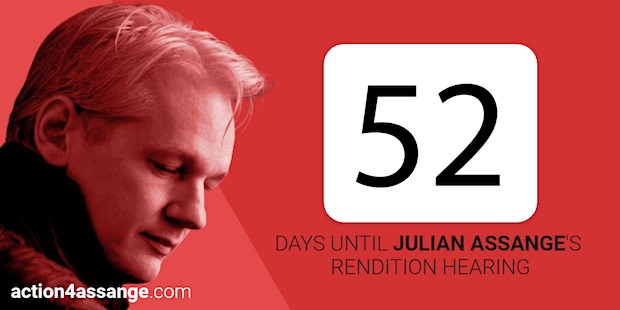

Support the Automatic Earth in virustime.



